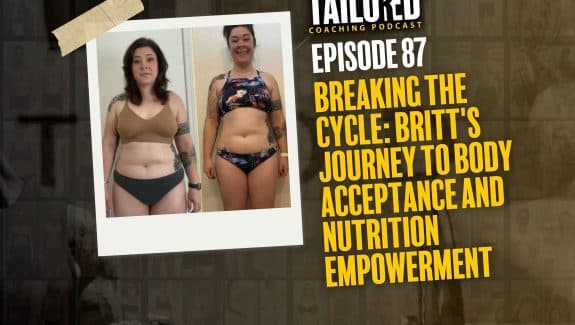Have you ever wondered how some people seem to effortlessly follow through with their workout regimen?
Or maybe you have struggled with sticking to a nutrition plan even when you understand the results it can provide?
We’ve all had struggles along our own nutrition & fitness journeys and, at one point or another, wished it was easier to implement healthy habits into our daily lives.
But why is it so hard to follow through on actions that we know will benefit us in the long term?
And why does it feel so tough to break those ‘bad’ habits we know aren’t serving us?
Unfortunately, this is primarily due to years and years of survival instincts encroaching on our comfy 21st century living.
As hunter-gatherers, we had to value the present situation more than a potential payoff in the future in order to survive.
That’s why it feels so much easier to eat the cookies today rather than stick with your grilled chicken salad in the hopes that you’ll see your body weight or measurements trend down next week.
Similarly, it’s hard to link your future goal of reaching your best ever physique to the act of NOT hitting snooze on your alarm tomorrow so you can squeeze in a workout.
So then how do all these “successful” people do it?
Ironclad willpower? Nope.
Daily self-discipline practice? Not quite.
They create habits!
Creating habits within your daily life that take you one step closer to your goal will allow you to change your lifestyle bit by bit and repeat healthy behaviors much more easily.
We’ll teach you exactly how within this guide!
What Are Habits?
According to James Clear, author of Atomic Habits, a habit is “a behavior that has been repeated enough times to become automatic.”
The pattern of this behavioral repetition flows through a loop like this:
1. Cue
First, there is some type of cue that triggers a behavior. This could be an event, situation, sight, etc.
2. Craving
Next comes the motivation that drives you to act. This is you interpreting the situation and connecting it with a thought, feeling, or emotion.
3. Response
Response is the action you perform following the cue and craving.
4. Reward
Lastly, the reward is satisfying your craving or completing the action from the previous step.
It is important to understand this habit loop because modifying any part of the process can allow you to break bad habits or build new, skillful habits.
Here’s an example of how to use the habit loop to break a bad habit:
I have struggled with binge eating in the past. Since I know this behavior is destructive to my health, lifestyle, and relationship with food, I wanted to break the cycle and quit those binges for good.
To break this unhealthy habit, I had to figure out what was causing me to binge eat in the first place
For me, I would binge when I was home alone, in my kitchen, after turning on the TV. The cues for bingeing that stood out to me after some self-reflection were standing in my kitchen with the TV on and being alone around highly palatable foods.
To break this habit, I changed my actions so that I did not eat in front of screens and I made it a point to not be aimless in my kitchen with the TV on or any other distractions. I also chose to only enjoy treats with others, which helped me slow down and eat mindfully.
These changes helped IMMENSELY because I was no longer putting myself in the situations that triggered binge eating. I wasn’t cueing that negative habit.
We can manipulate the habit loop in the same way to create new, skillful habits to achieve a goal. After setting a goal, you can detail out the habits needed to get you that end result and increase the cues, cravings, or rewards to help you stick to those new habits.
How To Build a New Habit
Get Specific
Do you know anyone who’s stuck to a goal that sounds something like, “I will workout more this year.” Probably not because it’s so vague! How can you even say if you achieved that or not? How would you stick to it or measure progress?
When you’re building a new habit, it’s best to keep it small and simple. There’s no need to try and overhaul your entire diet, lifestyle, and workout routine overnight. Pick ONE place to start and get specific with it.
One of the best ways to build a new, specific habit to get you to your goals is to fill out this sentence:
I will [behavior] at [time] in [location].
For example, I will workout from 5-6 Monday, Wednesday, and Friday at my local gym.
Or, I will meal prep from 12-1 on Sundays at my house.
Getting specific about what you need to do to achieve your goals will help you more easily say no to distractions that come up. It’s much harder to deviate from your plan when you nail it down using the above format.
Keep it simple and make it specific!
Implement Habit Stacking
Another strategy that James Clear mentions in his book is called habit stacking. This works exactly like it sounds – you are stacking a new habit you want to create on top of one that already exists.
If you want to add in mindfulness practice and are an avid coffee drinker, you might habit stack by committing to meditate for 5 minutes after you start the coffee brewing each morning.
After you are confident in one new habit you’ve stacked onto an existing habit, you can use this strategy to keep building upon that.
This is a great way to create a morning or evening routine! Take this morning example:
→ I start the coffee brewing and then I will meditate for 5 minutes.
→ After I meditate for 5 minutes, I write out three things I’m grateful for in my journal.
→ After I do my gratitude practice, I will pick my main task to accomplish for the day.
If you want to create an evening routine to improve your sleep and set yourself up for success the following day, your habit stack might look something like:
→ After I eat dinner, I get my gym bag ready for the morning.
→ After I get my gym bag ready, I turn off my phone and other devices.
→ After I turn off my devices, I read for 20 minutes in bed.
Tying your desired habit to something you already routinely do each day is a great way to ensure success with your new habits.
Make Your New Habit Obvious & Attractive
Since every habit is initiated by a cue, we are more likely to notice cues that stand out. This means that if you are trying to build a new habit, you want it to be obvious in your daily environment.
One great example I use with all of my clients is hydration! If you struggle drinking water, I always recommend keeping a water bottle with you at all times.
Treat yo’ self and buy a super cute new water bottle and carry it with you wherever you go. Keep it in a very obvious location like right by your computer or next to where you set your phone down.
This way you are glancing over towards your water frequently and that will remind you to take a sip.
Making a cue obvious is the exact opposite of the saying, “out of sight, out of mind!”
We also want the cue to be attractive. The more attractive an opportunity is, the more likely we will follow through with an action.
Let’s say you’re like me and you really hate doing cardio. Whenever my next contest prep roles around, I am dreading the day my coach increases cardio!!!
But I know I will need to complete my cardio sessions to reach my desired outcome, so I always try to pair cardio with something fun. Here are some strategies I’d recommend…
→ Call a family member or good friend while you do LISS
→ Create specific playlists that pump you up and save those for cardio time
→ Save your favorite podcast episode of the week for your hardest session
→ Sign up for a spin class with a friend to help hold you accountable & get some quality time with your #fitfam
→ If the weather is nice, take your cardio outside and enjoy the sunshine
→ When all else fails, plan your cutest workout outfits for cardio days to ensure you get your butt to the gym! 😉
If you’re struggling to turn something you dislike into a habit, pair it with a reward or something you already enjoy to make it more attractive.
Breaking Bad Habits
You can use almost the exact same strategies to break bad habits as you can to build new, skillful habits, like I mentioned early on with my binge eating example.
What is the cue of the habit you want to break? Remove those cues from your daily life.
Make the habit you want to break unattractive and difficult. Highlight the benefits of avoiding that habit and make the bad habit difficult to act upon by creating more work between you and the habit.
Let’s take the example of drinking alcohol. We’ll say that the cue to having a drink is getting home from work. You like to think of the drink as relaxing and a time to be social with your partner after a long day. You keep several nice bottles of wine out on display on the counter.
Now let’s say you want to cut back your alcohol consumption because you’re working on gut health and have fat loss goals.
→ First, change the cue of getting home from work = wine time.
⇒ You can’t totally remove this cue, but you can change your next action that you associate with it. Instead of getting home from work and pouring a drink, try getting home, taking 3 deep breaths when you step into your house, and putting on a pot of herbal tea. After repeating this a few nights in a row, you will come to associate getting home from work with calm and a nice cup of tea instead of wine.
→ Next, shift your mindset.
⇒ The booze isn’t truly relieving your stress, it’s actually causing more stress to your body and hindering your goals. And you might think you need a drink to be social or to relax, but that’s just not true. You can 100% be social without a drink and the three deep breaths you’re adding in will legitimately help your body shift into rest & recovery mode. Change your mindset and the way you view the bad habit.
→ You can also replace the habit of pouring a drink when you get home with the habit of greeting your partner with a kiss, snuggling with your pet, journaling, taking a walk, or really anything that truly does help relax the body and mind.
→ Lastly, make drinking more difficult.
⇒ Try keeping alcohol in the basement or not in the house at all. Tell anyone you live with that you’re challenging yourself to cut back. Put a post-it note on your mirror that reminds you of your goal. Anything you can do to make it require more effort to drink will work in your favor!
Just like you want new habits to be very easy, obvious, and attractive, make any habits you want to break difficult to follow through with, unattractive in your mind, and change the circumstances that cue the action.
What You Should Take Away:
→ Habits are automatic actions that we repeatedly do when prompted by a cue.
→ You can use the habit loop to change cues and/or rewards to build new habits or break bad habits.
→ When building new habits, keep them simple & get specific.
→ After you have confidence with one new habit, add in others using habit stacking.
→ Make your new habits stand out to you by making them obvious and attractive within your daily life.
→ To break bad habits, remove any cues to the negative behavior, change your mindset, and make the action very difficult to follow through with.
Work with your coach to figure out what habits you should add in to help get you to your end goal. Then use this guide to seamlessly integrate those skillful changes into your lifestyle and you’ll be able to make those healthy habits last a lifetime!























































































































































































































































































































































































































































































